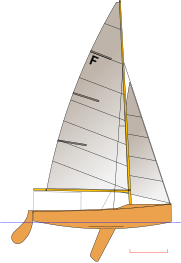Firefly (dinghy)
|
F
Class symbol
|
|
 |
|
| Crew | 2 |
|---|---|
| Hull weight | 74 kg (163 lb) |
| LOA | 3,660 mm (12 ft 0 in) |
| Beam | 1,420 mm (4 ft 8 in) |
| Upwind Sail Area | 8.36 m2 (90.0 sq ft) |
| D-PN | 99.6 |
| RYA PN | 1168 |
| Former Olympic class | |
The Firefly is a two-sail, one design, wooden or GRP sailing dinghy with no spinnaker, designed by Uffa Fox in 1938. The first four boats from the production line were named Fe, Fi, Fo and Fum. Number one, Fe, is now owned by the National Maritime Museum Cornwall. Although designed as a double hander, it was selected as the single handed class for the 1948 Olympics but was subsequently replaced by the Finn class. The class then became popular as a low cost, one design, double hander, as was originally intended, tolerating remarkably well combined weights of 16 to 25 stone (102 to 159 kg).
The Firefly class today has a thriving open events calendar in the UK. The national championships are always held at a sea venue and attracts a very high level of dinghy racing competitors in boats of all ages from all over the country and fleets of 60 entries plus. Away events are held at a number of the top end sailing clubs in the UK including Restonguet, Itchenor, West Kirby, Felixstowe Ferry, Southport, Budworth and Rickmansworth. It has become particularly successful as a team racing boat in the UK, thanks to its high manoeuvrability, easy handling, and low cost. Another benefit is the use of smaller mainsail which enables sailing in stronger winds. The class has become particularly popular for the British Universities Sailing Association team racing events and is used in similar BSDRA events, thus a large number of universities and schools that team race have a fleet of Fireflys, taking advantage of the benefits above.
The Firefly ideal was to produce a one-design dinghy at a low cost; this is why the class celebrated its 60th anniversary in 2006 and continues to grow. The Firefly appeals to all ages and is raced by both men and women. A more detailed history will be found on the class association website.
All modern hulls are made from GRP/fibreglass and hulls have to be ordered in advance for a batch of them to be made. E.g. universities and other institutions getting together to procure entire fleets of boats. Being made of GRP with aluminium spars makes the dinghy very light and thus fast in the right hands, putting emphasis on crew skill. They are also designed to be very simple, thus all parts are uniform, e.g. shackles and pulleys, helping to cater for a wider range of clients.
...
Wikipedia
